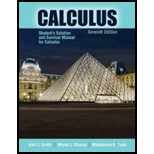
(a)
The meaning of slope of the tangent line.
(a)
Explanation of Solution
A tangent to a function
Tangent line is parallel to graph of function given in the problem.
So,
Slope of tangent line tells us the rate of change at a particular instant.
(b)
The comparison of slope of the tangent line to the slope of the secant line.
(b)
Explanation of Solution
Secant line is the line that touches the graph at a single point, that is not parallel to the graph of the function whereas tangent line is the line that touches the graph at a single point, that is parallel to graph of the function.
(c)
The meaning of normal line to a graph.
(c)
Explanation of Solution
Normal line is the line that is perpendicular to the tangent line to the graph of function given in the problem.
The slope of the normal line is the negative reciprocal of the slope of the tangent line.
A normal line can touch the graph of the function at more than one point.
Want to see more full solutions like this?
Chapter 3 Solutions
Student's Solution and Survival Manual for Calculus
- Write an equation for the polynomial graphed below 6+ 5 + -5 -4 3 y(x) = 4 3 2 1 -1 1 1 -1 -2 -3 -4 -5 2 3 4 5arrow_forwardWrite an equation for the polynomial graphed below 5+ 4 3 1 + + + -5-4-3-2 1 13 4 5 -1 -2 -3 -4 -5+ 4 5 Q y(x) =arrow_forward3. Solve the inequality, and give your answer in interval notation. - (x − 4)³ (x + 1) ≥ 0arrow_forward
- 1. Find the formula to the polynomial at right. Show all your work. (4 points) 1- 2 3 сл 5 6 -4 -3 -2 -1 0 2 3arrow_forward2. Find the leading term (2 points): f(x) = −3x(2x − 1)²(x+3)³ -arrow_forward1- √ √ √³ e³/√xdy dx 1 cy² 2- √ √² 3 y³ exy dx dy So 3- √ √sinx y dy dx 4- Jo √² Sy² dx dyarrow_forward
- A building that is 205 feet tall casts a shadow of various lengths æ as the day goes by. An angle of elevation is formed by lines from the top and bottom of the building to the tip of the shadow, as de seen in the following figure. Find the rate of change of the angle of elevation when x 278 feet. dx Round to 3 decimal places. Γ X radians per footarrow_forwardUse the information in the following table to find h' (a) at the given value for a. x|f(x) g(x) f'(x) g(x) 0 0 0 4 3 1 4 4 3 0 2 7 1 2 7 3 3 1 2 9 4 0 4 5 7 h(x) = f(g(x)); a = 0 h' (0) =arrow_forwardUse the information in the following table to find h' (a) at the given value for a. x f(x) g(x) f'(x) g'(x) 0 0 3 2 1 1 0 0 2 0 2 43 22 4 3 3 2 3 1 1 4 1 2 0 4 2 h(x) = (1/(2) ²; 9(x) h' (3)= = ; a=3arrow_forward
- The position of a moving hockey puck after t seconds is s(t) = tan a. Find the velocity of the hockey puck at any time t. v(t) ===== b. Find the acceleration of the puck at any time t. -1 a (t) = (t) where s is in meters. c. Evaluate v(t) and a (t) for t = 1, 4, and 5 seconds. Round to 4 decimal places, if necessary. v (1) v (4) v (5) a (1) = = = = a (4) = a (5) = d. What conclusion can be drawn from the results in the previous part? ○ The hockey puck is decelerating/slowing down at 1, 4, and 5 seconds ○ The hockey puck has a constant velocity/speed at 1, 4, and 5 seconds ○ The hockey puck is accelerating/speeding up at 1, 4, and 5 secondsarrow_forwardquestion 8arrow_forwardFind the area of the surface obtained by rotating the circle x² + y² = r² about the line y = r.arrow_forward
- Algebra & Trigonometry with Analytic GeometryAlgebraISBN:9781133382119Author:SwokowskiPublisher:Cengage

 Elementary AlgebraAlgebraISBN:9780998625713Author:Lynn Marecek, MaryAnne Anthony-SmithPublisher:OpenStax - Rice University
Elementary AlgebraAlgebraISBN:9780998625713Author:Lynn Marecek, MaryAnne Anthony-SmithPublisher:OpenStax - Rice University  Glencoe Algebra 1, Student Edition, 9780079039897...AlgebraISBN:9780079039897Author:CarterPublisher:McGraw Hill
Glencoe Algebra 1, Student Edition, 9780079039897...AlgebraISBN:9780079039897Author:CarterPublisher:McGraw Hill Holt Mcdougal Larson Pre-algebra: Student Edition...AlgebraISBN:9780547587776Author:HOLT MCDOUGALPublisher:HOLT MCDOUGAL
Holt Mcdougal Larson Pre-algebra: Student Edition...AlgebraISBN:9780547587776Author:HOLT MCDOUGALPublisher:HOLT MCDOUGAL





